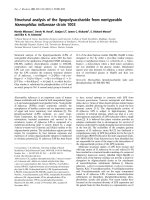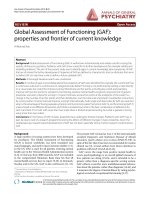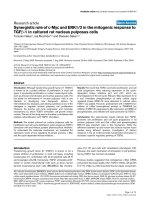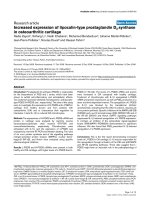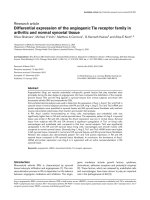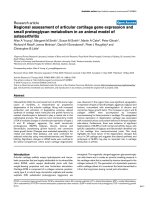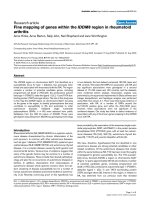Báo cáo y học: "Phylogenetic assessment of alignments reveals neglected tree signal in gaps" docx
Bạn đang xem bản rút gọn của tài liệu. Xem và tải ngay bản đầy đủ của tài liệu tại đây (772.91 KB, 9 trang )
Dessimoz and Gil Genome Biology 2010, 11:R37
/>Open Access
RESEARCH
© 2010 Dessimoz and Gil; licensee BioMed Central Ltd. This is an open access article distributed under the terms of the Creative Com-
mons Attribution License ( which permits unrestricted use, distribution, and reproduc-
tion in any medium, provided the original work is properly cited
Research
Phylogenetic assessment of alignments reveals
neglected tree signal in gaps
Christophe Dessimoz*
†1,2
and Manuel Gil
†1,2
Alignments for phylogeneticsTree-based tests of alignment methods enable the evaluation of the effect of gap placement on the inference of phylogenetic relationships.
Abstract
Background: The alignment of biological sequences is of chief importance to most evolutionary and comparative
genomics studies, yet the two main approaches used to assess alignment accuracy have flaws: reference alignments
are derived from the biased sample of proteins with known structure, and simulated data lack realism.
Results: Here, we introduce tree-based tests of alignment accuracy, which not only use large and representative
samples of real biological data, but also enable the evaluation of the effect of gap placement on phylogenetic
inference. We show that (i) the current belief that consistency-based alignments outperform scoring matrix-based
alignments is misguided; (ii) gaps carry substantial phylogenetic signal, but are poorly exploited by most alignment
and tree building programs; (iii) even so, excluding gaps and variable regions is detrimental; (iv) disagreement among
alignment programs says little about the accuracy of resulting trees.
Conclusions: This study provides the broad community relying on sequence alignment with important practical
recommendations, sets superior standards for assessing alignment accuracy, and paves the way for the development
of phylogenetic inference methods of significantly higher resolution.
Background
The study of biological sequences almost inevitably
begins with the process of alignment. The goal of this
process is usually to match homologous characters, that
is, characters that have a common ancestry [1]. In turn,
these sets of homologs, the columns of the alignment, can
be used for a variety of applications, such as identifying
residues with analogous structural or functional role, or
inferring the phylogenetic tree of the underlying
sequences. The accuracy of multiple sequence alignment
programs has been the object of numerous comparative
studies [2-4], which evaluate alignments either by using
trusted reference alignments obtained from structural
data, or by using simulation. Unfortunately, both
approaches have flaws. Trusted benchmark alignments
such as Balibase, Prefab, Homstrad, or Sabmark [5-8] are
all derived from protein structure information, exploiting
the tendency of structure to evolve more slowly than
sequence [9].
However, proteins with resolved structure remain a
small and highly biased sample of all proteins [10,11]. In
addition, homology inferred from structural information
is inherently restricted to conserved regions, thereby pro-
viding little guidance for correct gap placement. The
other approach to validating alignments is simulation
[12-18]. Yet, results obtained from simulated data
strongly depend on the choice of model used to generate
the data, and most biological processes are difficult to
model realistically. For instance, current insertion-dele-
tion models are known to be insufficient [19]. Even if a
good model can be formulated, it will never fully capture
the complexity of real biological data. Consequently, the
results observed on simulated data differ significantly
from those measured on empirical data [1].
Results and discussion
There is, therefore, a need for alternative evaluation pro-
cedures that do not rely on structural information while
applicable to a large and representative sample of real
biological data. In this work, we propose two such tests.
* Correspondence:
1
Department of Computer Science, ETH Zurich, Universitaetstr. 6, 8092 Zürich,
Switzerland
†
Contributed equally
Full list of author information is available at the end of the article
Dessimoz and Gil Genome Biology 2010, 11:R37
/>Page 2 of 9
We then show how they offer answers to three of the
most important open questions regarding sequence
alignment for phylogenetic inference: (i) Which align-
ment approach leads to the most accurate trees? (ii) Are
gap regions informative for phylogenetic inference or
should they be ignored? (iii) What is the impact of align-
ment uncertainty on tree inference?
Phylogeny-based tests of alignment accuracy
The principle of the phylogeny-based tests of alignment
accuracy is simple: the more accurate the resulting trees,
the more accurate the alignments (in terms of homology
matching) are assumed to be. Therefore, we can use tree
accuracy as surrogate for alignment accuracy. The first
phylogeny-based test we propose ('species-tree discor-
dance') compares alignments of orthologous genes from
species whose phylogeny is resolved and undisputed (Fig-
ure 1). By Fitch's definition of orthology [20], trees
inferred from orthologs are expected to have the same
topology as the underlying species. Thus, holding all else
constant, if a particular method produces alignments that
result more frequently in trees congruent with the phy-
logeny of the species, it is likely to be more accurate. A
similar idea was previously used in the context of model
comparison [21], and verification of orthology [22]. The
second test ('minimum duplication') takes homologous
sequences as input and uses a parsimony argument rather
than knowledge about the phylogeny of the species: hold-
ing all else constant, the gene tree with the least number
of duplication nodes is the most likely (Figure 1, [23-25]).
Hence, if a sequence alignment method results in tree
topologies with consistently fewer duplications, it is likely
to produce better alignments. Given a tree, a conservative
estimate of the number of duplication events can be
obtained using the concept of species overlap [26]. By
accepting practically any gene family as input, the two
tests can be performed on sequences relevant to a given
biological study. Moreover, note that by design, the tests
are robust to sources of errors that affect all alignment
methods equally on average, such as stochastic errors in
tree inference, lateral gene transfers, or the choice of evo-
lutionary model. For instance, although the parsimony
assumption may occasionally underestimate the true
number of duplicated genes (for example, in gene families
with many duplications/losses), as long as this underesti-
mation does not favor a particular alignment method, the
ranking of the methods is unaffected.
Assessment of alignment methods
To address the question of alignment accuracy, we used
the tests to evaluate 13 MSA software packages, which
can be classified into roughly three alignment scoring
strategies: scoring matrix-based Mafft FFT-NS-2, Muscle,
Clustal W2, DiAlign/-T/-TX, Kalign [6,27-33]; consis-
tency-based Mafft L-INS-i, T-Coffee, Mummals, Prob-
Cons, ProbAlign [27,28,34-37]; and tree-aware-gap-
placing Prank [38]. We tested the alignment software
both on amino-acid and on nucleotide data, with the
Figure 1 Schematic of the phylogeny-based tests of alignment accuracy. Both tests are based on large-scale genomic data: (a) The species-tree
discordance test samples sets of orthologs inferred by OMA among species with a well-accepted phylogeny (Additional file 1, Figure S1). Each sample
is aligned by the different packages. The resulting alignments are evaluated by reconstructing trees from them, and comparing with the reference
topology. All else being equal, trees from better alignment packages show higher average congruence with the reference topology. (b) The minimum
duplication test follows a similar idea, but differs from the first test in two ways. First, it samples sets of homologs rather than the more specific or-
thologs. Second, the evaluation is based on a parsimony argument rather than knowledge about the phylogeny of the species: all else being equal,
alignments yielding trees with fewer duplication nodes on average are more accurate.
2. Alignment 3. Tree building 4. Tree evaluation1. Sequence
sampling
(b) Minimum duplication test
Homologous
sequences
2 dupl.
2 dupl.
1 dupl.
Compute min number of
(a) Species-tree discordance test
66%
100%
50%
Orthologous
sequences
Compare to
MOUSE
YEAST
ECOLI
Gene
Orthologs
Paralogs
Complete genomes
OMA orthology inference
Clustal W
T-Coffee
Mafft
Clustal W
T-Coffee
Mafft
reference t opology
gene duplication
Dessimoz and Gil Genome Biology 2010, 11:R37
/>Page 3 of 9
exception of Mummals and ProbCons, which only run on
amino-acid data. For the species-tree discordance test,
we sampled sets of 6 orthologs as inferred by OMA [39]
among 57 eukaryotic, 11 fungal, and 418 bacterial
genomes, under the constraint that the branching order
of the species represented in each set be well-accepted
(Additional file 1, Figure S1). For the minimum duplica-
tion test, we retrieved groups of up to 60 homologs from
18 metazoan and 18 fungal genomes. Trees were recon-
structed by maximum likelihood (ML) from both amino-
acid and nucleotide alignments. In addition, to compare
the two types of alignments under the same evolutionary
model, ML trees were also reconstructed from back-
translated amino-acid alignments, using the actual
codons from the corresponding nucleotide sequences. In
total, the tests required computing over 100,000 align-
ments of up to 60 sequences, at a cost of over 20,000 CPU
hours.
In general, we observed fewer differences among pro-
grams aligning amino-acids than aligning nucleotides
(Figure 2). Trees from nucleotide alignments fared signif-
icantly worse than those from back-translated amino-
acid alignments in practically all cases. Since the only dif-
ference between the two types of trees resides in the
alignment process, we conclude that current alignment
packages align amino-acids more accurately than nucle-
otides (Additional file 1, Figure S7), as previously
observed in simulation by [13]. In terms of alignment
strategy, and contrary to current beliefs [3,4], consis-
tency-based alignment methods as a class did not outper-
form their scoring matrix-based counterparts, yet they
were up to 300 times slower (Figure 2, Additional file 1,
Figure S6). Thus, the additional time spent by consis-
tency-based programs did not necessarily translate into
more accurate trees. In addition, the consistency-based
methods surveyed here tended to perform unevenly
across different datasets, which suggests that their under-
lying models and/or parameters are relatively sensitive to
input data characteristics. The potential misguidance of
current benchmarks is exemplified in the results obtained
from the different versions of DiAlign: although both
simulated and structure-based reference alignments indi-
cated that DiAlign had significantly improved over the
course of the three releases investigated here [32], the
present tests do not support this conclusion. While sig-
nificant differences among the versions can be observed
in particular datasets, no DiAlign variant demonstrated
superior performance. In terms of individual programs,
only small differences could be observed with amino-acid
sequences. It nonetheless appears that DiAlign TX and
Prank were consistently among the best programs (Addi-
tional file 1, Figure S6). With nucleotide sequences, the
differences were greater. Mafft L-INS-i was the only
package consistently among the best on nucleotide data.
At the other end of the spectrum, T-Coffee, KAlign and
DiAlign T exhibited subpar nucleotide alignment perfor-
mance. Overall, as we have seen that alignments are
almost invariably more accurate on amino-acid data, the
best nucleotide alignments are obtained by back-translat-
ing amino-acid alignments.
To limit the risk of systematic biases or unrecognized
factors, these observations were confirmed by two kinds
Figure 2 Comparison of alignment methods. Assessment of various alignment methods under default parameters using (a) the species-tree dis-
cordance and (b) the minimum duplication tests, on eukaryotic data. Consistency-based alignment methods do not improve over scoring matrix-
based methods. The relative performance between alignment programs is more variable for nucleotide data than for amino-acid data. On amino-acid
data, Mafft-FFT-NS-2, DiAlign TX and Prank were never outperformed; on nucleotide data, Mafft L-INS-i (right column) was never outperformed (see
also Additional file 1, Figure S6). Average compute times (per alignment) are plotted as triangles (amino-acids) and circles (nucleotides). Error bars
correspond to ± 1 s.d. Significant difference from best alignment program is denoted with a minus symbol at the basis of relevant bars (Wilcoxon
double-sided test, P < 0.01).
10.00
15.00
20.00
25.00
30.00
Mafft FFT-NS-2
Muscle
Clustal W2
DiAlign
DiAlign T
DiAlign TX
Kalign
Mafft L-INS-i
T-Coffee
Mummals
ProbCons
ProbAlign
Prank+F
0.1
1
10
100
Percentage wrong splits
Time [log(sec)]
Scoring matrix
(a) (b)
Amino-acid alignment Nucleotide alignment
7.50
8.00
8.50
9.00
9.50
Mafft FFT-NS-2
Muscle
Clustal W2
DiAlign
DiAlign T
DiAlign TX
Kalign
Mafft L-INS-i
T-Coffee
Mummals
ProbCons
ProbAlign
Prank+F
10
100
1000
10000
Mean number of duplications
Time [log(sec)]
Scoring matrix
Amino-acid alignment
Nucleotide alignment
- - -
Consistency Consistency
Dessimoz and Gil Genome Biology 2010, 11:R37
/>Page 4 of 9
of controls. First, we considered the effect of the tree
building method used in the test procedure. We ran the
tests under a different model of evolution and using least
squares distance trees instead of ML. The results were
highly consistent (Additional file 1, Figures S8 and S9, rel-
ative accuracy of the two methods correlates with 0.90, P
< 10
-10
, t-test). Second, we tested the dependence of the
results on characteristics of the input data. We re-evalu-
ated the tests on partitioned data and estimated the cor-
relations between the relative accuracy of each partition
with its full datasets. The data was segmented according
to sequence length (Additional file 1, Figure S10, r = 0.62,
P < 10
-10
), sequence divergence (Additional file 1, Figure
S11, r = 0.67, P < 10
-10
) and number of sequences (Addi-
tional file 1, Figure S12, r = 0.89, P < 10
-10
). Furthermore,
we contrasted the results of different pairs of lineages
(Additional file 1, Figure S6, 0.68 <r ≤ 0.94, all P < 10
-3
). In
all cases, our conclusions above stand.
Guide trees make or break progressive alignments
Since sequence insertion and deletion events are gener-
ally assumed to take place along a tree, most aligners rely
on guide trees to construct and score alignments. Some
of them - in our case Mafft, Muscle, Clustal W2, T-Coffee
and Prank - allow specification of the guide tree by the
user. To investigate their sensitivity to tree specification,
we ran the species-tree discordance test on two extreme
cases: we provided either a random guide tree, or the ref-
erence species tree as guide (Additional file 1, Figure
S13). Unsurprisingly, the input trees hardly affected
methods refining their guide trees iteratively (Muscle) or
relying strongly on consistency (T-Coffee), a mostly tree-
independent objective function. In contrast, strictly pro-
gressive methods (Mafft-FFT, Clustal W2, Prank) were
highly sensitive to the provided guide tree. With such
methods, guide tree specification is a double-edged
sword: prior knowledge of the underlying sequence phy-
logeny, depending on its accuracy, can either improve the
resulting alignments, or worsen them. Consequently, if
the tree is known with high confidence, we recommend
using it in conjunction with Prank or Mafft. If not, one
might wonder which program infers the best guide trees,
and whether feeding them to the other aligners could
improve results overall. Our results suggest that on aver-
age, the best guide trees are inferred by Prank on amino-
acid data, and Mafft on nucleotide data (Additional file 1,
Figure S14). The difference is however not sufficiently
large that the other alignment methods consistently
profit from these improved guide trees (Additional file 1,
Figure S15).
Gaps carry substantial unexploited tree signal
A notable advantage of our evaluation approach lies in its
capacity to assess the accuracy and phylogenetic informa-
tion content of gap regions. Given that structural align-
ments are inherently limited to regions of conserved
structure, previous assessment of gap region accuracy
were typically performed on simulated data only (for
example, [40]). Using simulation, Löytynoja and Gold-
man, the authors of Prank, have recently argued that
other alignment programs infer less phylogenetically
plausible alignments [41]. However, though competitive,
Prank did not show a clear advantage over the other
alignment strategies in the tests described above, espe-
cially considering its much higher computational cost
(Figure 2). As it turns out, this is mainly a consequence of
gap treatment in current ML tree building methods: by
modeling each gap position as unknown character, they
ignore much of the phylogenetic signal from gaps. To
assess the phylogenetic signal of gaps, we repeated our
tests using a tree inference method that only uses gap sig-
nals: maximum parsimony on binary gap/no-gap charac-
ters. On amino-acid data, the results using gap parsimony
trees clearly show that Prank outperforms the other pro-
grams regarding gap placement on real biological
sequences, at times quite dramatically (Figure 3a). On
nucleotide data, Prank was occasionally surpassed by one
of the DiAlign variants, but showed solid performance
overall (Additional file 1, Figure S16). More importantly,
although parsimony trees obtained from gaps are on
average much less accurate than ML trees from substitu-
tions, with Prank, the difference between the two consid-
erably diminishes, especially at high levels of sequence
divergence (Figure 3b). In one extreme case (fungal
nucleotide data, species-tree discordance test), the gap
parsimony trees from alignments by Prank largely sur-
passed the ML trees from alignments by several other
methods (Additional file 1, Figures S6 and S16). The
broader implication of these results is that gaps carry sig-
nificant phylogenetic signal, information that is currently
ignored by most alignment and tree reconstruction pro-
grams (and certainly not completely exploited in the sim-
plistic parsimony approach employed here). We stress
that this unexpected result could only be observed by
combining the recent improvements in alignment
afforded by Prank, our alignment evaluation methods,
and a tree inference procedure that exploits gap patterns.
Excluding gaps and variable regions harms
It has been argued that even if gap regions carry potential
phylogenetic signal, inclusion of these regions, which are
usually more difficult to align than conserved ones,
results in an overall decrease in the signal-to-noise ratio
of alignments [42]. And indeed, the common recommen-
dation of excluding 'gaps and ambiguous sites' in phyloge-
netic analyses tends to support this view as well. Even so,
in some cases, studies on particular gene families [43,44],
or using simulation [18,45], have supported the opposite
Dessimoz and Gil Genome Biology 2010, 11:R37
/>Page 5 of 9
view. We investigated this issue by comparing trees
reconstructed from full alignments versus from align-
ments without gap columns (that is, without columns
containing gaps), and full alignments versus alignments
curated by Gblocks [42]. By default, Gblocks identifies
and removes both gap columns and variable regions. For
amino-acid alignments, excluding gap columns never
improved tree accuracy, and often worsened it (Figure 4,
Additional file 1, Figures S18 and S19). Removing variable
regions in addition to gaps, as performed by Gblocks, had
a strong negative impact on the accuracy of trees. For
nucleotide alignments, the effects were not nearly as det-
rimental; in some cases, the filtering helped (Additional
file 1, Figure S19). But remember that alignment pro-
grams often have difficulty with nucleotide sequences;
almost invariably, the best trees were obtained from
unfiltered, amino-acid sequence alignments. Most strik-
ing about these findings is that, as pointed out above, the
standard tree building methods used here do not exploit
gap patterns; it appears that character substitution pat-
terns inside gap and variable regions carry enough phylo-
genetic signal to warrant inclusion of those segments
under current methods.
Alignment variability poorly predicts tree accuracy
We have seen that different alignment programs can give
rise to trees of varying accuracy. But in the broader con-
text of tree inference, sequence alignment is not the only
source of tree uncertainty. By 'uncertainty', we mean the
expected addition of systematic and random error, that is,
the expected inaccuracy. For instance, the amount of
input data (that is, sequence lengths), the divergence
between sequences, the model of evolution, or the tree
searching algorithm all affect the accuracy of recon-
structed trees, and one's confidence therein. This raises
the question of the relative contribution of alignment
uncertainty to tree uncertainty. Wong et al. recently
quantified the observation that different alignment pro-
grams often lead to different tree topologies [46]. They
found a correlation (Spearman-rank correlation r
s
= 0.53)
between alignment variability (average distance between
alignments from different methods) and tree variability
(average topological distance among trees estimated from
different alignment methods). But constrained by a lack
of measure of total tree error, their analysis only focused
on the random component of tree uncertainty. We
exploited the tree accuracy measure from the species-
tree discordance test to estimate the correlation between
alignment variability and tree accuracy. Interestingly,
accounting for both random and systematic errors sug-
gests a weaker connection between alignment and tree
quality: the negative correlation between alignment vari-
ability and tree accuracy was low for amino-acid and
back-translated data (Additional file 1, Figure S20, -r
s
<
0.16, P < 0.01, t-test). Thus, alignment variability says lit-
tle about overall tree uncertainty for amino-acid align-
ments. To put the results into perspective, we also
estimated the correlation between bootstrap tree support
and tree accuracy. Surprisingly, even though bootstrap
Figure 3 Phylogenetic signal of gaps. (a) Assessment of gap accuracy under default parameters using the species-tree discordance test with par-
simony trees on presence/absence patterns of gap characters in aminoacid alignments. By taking into account gap information, this test demon-
strates that the gap placement of Prank is significantly better than other alignment methods. This cannot be observed either using standard tree
building methods (Figure 2), or using structure-based benchmarks. Error bars correspond to ± 1 s.d. Significant difference from Prank is denoted with
a minus symbol at the basis of relevant bars (Wilcoxon double-sided test, P < 0.01). (b) Accuracy of maximum likelihood (ML) trees on amino-acid
substitution patterns versus parsimony on binary gap presence/absence characters, on fungal data. The phylogenetic signal of gaps inferred by Prank
increases with divergence. For distant sequences, the proportion of correctly inferred splits from gaps alone is close to that from amino-acids substi-
tutions by ML. Thus, tree building methods could capture up to twice as much phylogenetic signal from the same data. Moreover, note that the crude
approach used here to infer the gap trees likely understates the potential of gap patterns.
(a)
(b)
30.00
40.00
50.00
60.00
70.00
80.00
Mafft FFT-NS-2
Muscle
Clustal W2
DiAlign
DiAlign T
DiAlign TX
Kalign
Mafft L-INS-i
T-Coffee
Mummals
ProbCons
ProbAlign
Prank+F
Percentage wrong splits
Scoring matrix Consistency
Eukaryota
Fungi Bacteria
0
10
20
30
40
50
60
70
25 30 35 40 45 50 55 60 65 70 75
Percentage wrong splits
Percentage sequence identity
Mafft FFT-NS-2 (ML)
Clustal W2 (ML)
DiAlign T (ML)
Mafft L-INS-i (ML)
T-Coffee (ML)
Prank+F (ML)
Mafft FFT-NS-2 (gap parsimony)
Clustal W2 (gap parsimony)
DiAlign T (gap parsimony)
Mafft L-INS-i (gap parsimony)
T-Coffee (gap parsimony)
Prank+F (gap parsimony)
Dessimoz and Gil Genome Biology 2010, 11:R37
/>Page 6 of 9
assumes correct alignments, it was a consistently better
predictor of tree accuracy than alignment variability
(Additional file 1, Figure S20, r
s, Bootstrap
> -r
s, AlignmentVar
, P
< 0.006, see methods). For nucleotide alignments, shown
above to be often worse than amino-acid alignments, we
found a higher correlation between alignment variability
and tree accuracy than for the amino-acid counterparts.
Still, alignment variability was never a better predictor of
tree accuracy than tree support (Additional file 1, Figure
S20). Since tree support is usually computed anyway, this
casts doubt on the usefulness of trying more than one
alignment method for the purpose of phylogenetic infer-
ence [47]. Rather, we recommend that practitioners stick
with an accurate alignment method, as identified by tests
such as the ones presented here.
Conclusions
In summary, the use of trees rather than protein structure
to assess alignments is advantageous in that it more
closely fits a common application of alignments, it is not
restricted to the relatively small and biased sample of pro-
teins with known structure, and it also allows the evalua-
tion of gap regions. Indeed, our results show that
consistency-based alignment methods, which score best
in structural benchmarks, do not yield significantly better
trees than their scoring matrix-based counterparts. Our
tests also demonstrate that gaps often carry a strong phy-
logenetic signal, which at present is not well exploited,
either by most alignment methods, or by standard tree
building methods; but even with such methods, excluding
gaps and variable regions worsen the resulting trees.
Finally, the low correlation we observed between align-
ment variability and tree accuracy suggests that there is
little to gain from the common practice of trying more
than one alignment program on a given dataset. This lat-
ter result, as well as the analysis on the impact of guide
tree specification, rely exclusively on the species-tree dis-
cordance test, because they require knowledge of a refer-
Figure 4 Effect of excluding gaps and variable regions. The plot shows the effect of filtering on the minimum duplication test with back-translat-
ed, fungal amino-acid alignments. Removing gapped sites tends to worsen the accuracy of the induced maximum likelihood trees. Removing variable
regions in addition to gapped sites (Gblocks, default settings) drastically reduces the accuracy of reconstructed trees. Error bars correspond to ± 1 s.d.
Significant difference between results from original and curated alignments is denoted with a minus symbol at the basis of relevant bars (Wilcoxon
double-sided test, P < 0.01).
2.10
2.20
2.30
2.40
2.50
2.60
2.70
2.80
Mafft FFT-NS-2
Muscle
Clustal W2
DiAlign
DiAlign T
DiAlign TX
Kalign
Mafft L-INS-i
T-Coffee
Mummals
ProbCons
ProbAlign
Prank+F
Mean number of duplication
Scoring matrix Consistency
Not curated
Gap removed Gblocks
Dessimoz and Gil Genome Biology 2010, 11:R37
/>Page 7 of 9
ence topology. As such, the conclusions are based on six-
taxa trees only. How well they generalize to larger trees is
yet to be investigated. Besides, further interesting ques-
tions remain: how do alignment methods perform on
data not represented in this study, such as promoter
regions or other non-coding sequences? How can we best
extend our current models of sequence evolution to take
into account the phylogenetic signal of gap patterns? How
do the methods investigated here compare with the sta-
tistical approach of joint alignment and tree inference?
The methodology introduced here gives us the means to
investigate these issues. Beyond alignments, the ability to
measure tree accuracy under realistic conditions allows
assessment of further important aspects of phylogeny
inference, such as evolutionary models, tree building
algorithms, or tree confidence measures.
Materials and methods
Sets of orthologous protein sequences
The Species Tree Discordance Test was performed on
three sets of species: eukaryotes, fungi, and bacteria
(detailed list in Supplementary Information Sect. 1.1). For
all three sources of data, we retrieved sets of orthologs as
inferred by OMA (Release of September 2008) [48].
Although cases of misclassification cannot be excluded, it
has been shown in a previous study that the false-positive
rate of OMA's predictions is low compared with other
similar projects [22]. More importantly, though the pres-
ence of non-orthologs reduces the power of our test, it
does not bias the results toward a particular alignment
program. Sequences were sampled according to reference
trees with a comb topology (Additional file 1, Figure S1).
This topology ensures that all sequences in a sample are
orthologous to each other [22]. In each trial, a starting
sequence from a random species in the innermost leaf
was randomly chosen. Then, for each remaining leaf, a
random orthologous sequence was sampled.
Sets of homologous protein sequences
We performed the Minimum Duplication test on two sets
of organisms: metazoa and fungi (detailed list in Supple-
mentary Information Sect. 1.2). Sets of homologs were
constructed by taking the transitive closure of pairs of
sequences with high alignment scores (E-value below 10
-
10
). The sets were restricted to a maximal size of 60
sequences by removing sequences randomly from sets of
excessive cardinality.
Definition: absolute minimum number of duplications
For any set of homologous genes, consider partitions of
the sequences according to their genome of origin: each
resulting partition consists of same-species paralogs. Let
m be the maximum cardinality of these partitions. For m
paralogs to be observed in the same genome, at least m-1
duplications had to take place. We denote m-1 as absolute
minimum number of duplications for the set of homologs.
Species-tree discordance test
The species-tree discordance test evaluates a sequence
alignment program in terms of the average accuracy of
the trees reconstructed from its alignments. The test
requires a large number of sequence sets whose phylog-
eny is known. Given that orthologous genes (by defini-
tion) follow the species tree, we sampled orthologs
provided by OMA [48] from species with known and
undisputed branching order (Additional file 1, Figure S1).
Agreement between obtained and reference topologies
was quantified by the proportion of wrong splits [49].
Minimum duplication test
In a gene tree, the split of two same-species paralogs is
necessarily a duplication event. By a parsimonious argu-
ment, the tree with the least duplication splits represents
the most likely evolutionary history. The minimum dupli-
cation test evaluates a sequence alignment program in
terms of the average minimum number of gene duplica-
tion events implied in the trees reconstructed from its
alignments of homologous sequences. Given a rooted
tree, a lower bound on the number of duplications can be
obtained by counting nodes that have subtrees with over-
lapping sets of species [26]. Since the placement of the
root of the tree is usually unknown, we considered all
possible rootings and retained the minimum number of
duplications. This measure was normalized by subtract-
ing the absolute minimum number of duplications from it
(see above). An example computation can be found in
Additional file 1, Figure S2.
Tree reconstruction
Gene trees were reconstructed by maximum likelihood
using PhyML v. 2.4.4 [50] from the sequences aligned
with the different programs under JTT+I+Γ for amino-
acids and HKY+I+Γ for nucleotides. To investigate the
accuracy of gap placement, the two tests were also per-
formed using Wagner parsimony on the presence/
absence patterns of gaps (for a given alignment, each col-
umn containing at least one gap was considered a charac-
ter and the presence/absence of a gap its state). To avoid
over-counting, neighboring columns with identical gap-
patterns were combined into single characters.
Alternative tree building methods
As control, we recomputed the trees using a least-square
distance approach instead of maximum likelihood: we
reconstructed variance weighted least-squares distance
trees using the MinSquareTree function in Darwin [51].
The pairwise input-distances were computed by maxi-
mum likelihood using the GCB matrices [52] for amino-
acid data. For nucleotide data we used an unpublished,
Dessimoz and Gil Genome Biology 2010, 11:R37
/>Page 8 of 9
empirical nucleotide substitution matrix estimated from
mammalian orthologs in OMA [48]. Likewise, as an alter-
native (and control), we recomputed the Gap Parsimony
Trees without combining repeated columns. Further-
more, for a subset of the tests we repeated the computa-
tion of the ML trees using the software RAxML v. 7.0.4
[53].
Filtering of gaps and variable regions
We define a gap column as a column of the multiple
sequence alignment in which at least one sequence has a
gap character. To filter both gaps and variable regions, we
used Gblocks version 0.91b [42] with default settings. In
addition and as control, we also relaxed the settings
according to Talavera et al. [42]. At times, any of the three
filtering variants (no gap, Gblocks default, Gblocks
relaxed) could yield alignments with no column left, that
is, of null length. Such samples were excluded.
Measures to relate alignment uncertainty to tree inference
The measures used in the section Alignment Variability
Poorly Predicts Tree Accuracy and Additional file 1, Fig-
ure S18 are defined as follows: Tree accuracy was mea-
sured by one minus the normalized Robinson-Foulds
distance [49] between the inferred and the accepted
topology. Tree support was measured by the proportion
of bootstrap replicates agreeing with the inferred topol-
ogy. Tree variability was measured by the average Robin-
son Foulds distance among trees estimated from different
alignment methods. Alignment variability was measured
by the average distance between alignments [54] from
different alignment methods. This measure has been
shown [46] to strongly correlate (Spearman's rank corre-
lation r
s
= 0.92, P < 0.0001) with Bayesian-inferred align-
ment variability.
Comparing two correlation coefficients
We have stated in the main text (see also Additional file 1,
Figure S18) that tree support (BS) is a better predictor for
tree accuracy (TA) than alignment variability (AV ). This
can be assessed by the following test: As a null hypothe-
sis, equal predictive power of the two measures is
assumed, that is r
s
(BS, TA) = -r
s
(AV, TA). The observation
(Additional file 1, Figure S18) that for all datasets r
s
(BS,
TA) > -r
s
(AV, TA) is formulated as an alternative hypothe-
sis. We assume that the pair samples are normal bivariate
distributed.
is approximately standard normal distributed, where
z(·) denotes the Fisher Z-transform.
Additional material
Authors' contributions
CD and MG contributed equally to this work.
Acknowledgements
We thank Olivier Gascuel for early ideas leading to the design of the minimum
duplication test, and Adrian Altenhoff, Maria Anisimova, Gina Cannarozzi, Gas-
ton Gonnet, Heather Murray, Adrian Schneider, Jörg Stelling, Hervé Vander-
schuren, as well as two anonymous reviewers for helpful remarks on the
manuscript.
Author Details
1
Department of Computer Science, ETH Zurich, Universitaetstr. 6, 8092 Zürich,
Switzerland and
2
Swiss Institute of Bioinformatics, Universitaetstr. 6, 8092
Zurich, Switzerland
References
1. Kemena C, Notredame C: Upcoming challenges for multiple sequence
alignment methods in the high-throughput era. Bioinformatics 2009,
25:2455-2465.
2. Blackshields G, Wallace IM, Larkin M, Higgins DG: Analysis and
comparison of benchmarks for multiple sequence alignment. In Silico
Biol 2006, 6:321-339.
3. Edgar RC, Batzoglou S: Multiple sequence alignment. Curr Opin Struct
Biol 2006, 16:368-373.
4. Notredame C: Recent evolutions of multiple sequence alignment
algorithms. PLoS Comput Biol 2007, 3:e123.
5. Thompson J, Koehl P, Ripp R, Poch O: BAliBASE 3.0: latest developments
of the multiple sequence alignment benchmark. Proteins 2005,
61:127-136.
6. Edgar RC: MUSCLE: a multiple sequence alignment method with
reduced time and space complexity. BMC Bioinformatics 2004, 5:113.
7. Stebbings LA, Mizuguchi K: HOMSTRAD: recent developments of the
homologous protein structure alignment database. Nucleic Acids Res
2004, 32:D203-7.
8. Van Walle I, Lasters I, Wyns L: SABmark - a benchmark for sequence
alignment that covers the entire known fold space. Bioinformatics 2005,
21:1267-1268.
9. Chotia C, Lesk A: The relation between the divergence of sequence and
structure in proteins. EMBO J 1986, 5:823-826.
10. Peng K, Obradovic Z, Vucetic S: Exploring bias in the Protein Data Bank
using contrast classifiers. Pac Symp Biocomput 2004:435-446.
11. Xie L, Bourne P: Functional coverage of the human genome by existing
structures, structural genomics targets, and homology models. PLoS
Comput Biol 2005, 1:e31.
12. Rosenberg MS: Evolutionary distance estimation and fidelity of pair
wise sequence alignment. BMC Bioinformatics 2005, 6:102.
13. Hall BG: Comparison of the accuracies of several phylogenetic methods
using protein and DNA sequences. Mol Biol Evol 2005, 22:792-802.
14. Ogden TH, Rosenberg MS: Multiple sequence alignment accuracy and
phylogenetic inference. Syst Biol 2006, 55:314-328.
15. Nuin PAS, Wang Z, Tillier ERM: The accuracy of several multiple sequence
alignment programs for proteins. BMC Bioinformatics 2006, 7:471.
16. Kumar S, Filipski A: Multiple sequence alignment: in pursuit of
homologous DNA positions. Genome Res 2007, 17:127-135.
17. Landan G, Graur D: Characterization of pairwise and multiple sequence
alignment errors. Gene 2009, 441:141-147.
d
zr
s
BS TA z r
s
AV TA
n
BS TA
n
AV TA
=
−−
−
−
+−
−
(( , )) ( ( , ))
(
,
)(
,
)3
1
3
1
Additional file 1 Supplementary information. A 34-page PDF file with
(1) description of software and sequence data and software, in particular
supplementary figures S1 to S5; (2) an example for the computation of the
evaluation criterion in the Minimum Duplication Test; (3) additional support
and controls for the results presented in the main text, mainly consisting of
supplementary figures S6 to S24; (4) description of the raw results, which
can be downloaded in their entirety.
Received: 21 August 2009 Revised: 26 January 2010
Accepted: 6 April 2010 Published: 6 April 2010
This article is available from: 2010 Dessimoz and Gil; licensee BioMed Central Ltd. This is an open access article distributed under the terms of the Creative Commons Attributi on License ( which permits unrestricted use, distribution, and reproduction in any medium, provided the original work is properly citedGenome Biology 2010, 11:R37
Dessimoz and Gil Genome Biology 2010, 11:R37
/>Page 9 of 9
18. Wang LS, Leebens-Mack J, Wall PK, Beckmann K, dePamphilis CW, Warnow
T: The impact of multiple protein sequence alignment on phylogenetic
estimation. IEEE/ACM Trans Comput Biol Bioinform 2009 in press.
19. Strope CL, Abel K, Scott SD, Moriyama EN: Biological sequence
simulation for testing complex evolutionary hypotheses: indel-Seq-
Gen version 2.0. Mol Biol Evol 2009, 26:2581-93.
20. Fitch WM: Distinguishing homologous from analogous proteins. Syst
Zool 1970, 19:99-113.
21. Schneider A, Gonnet G, Cannarozzi G: SynPAM-a distance measure
based on synonymous codon substitutions. IEEE/ACM Trans Comput Biol
Bioinform 2007, 4:553-60.
22. Altenhoff AM, Dessimoz C: Phylogenetic and functional assessment of
orthologs inference projects and methods. PLoS Comput Biol 2009,
5:e1000262.
23. Goodman M, Czelusniak J, Moore GW, Romero-Herrara AE: Fitting the
gene lineage into its species lineage: a parsimony strategy illustrated
by cladograms constructed from globin sequences. Syst Zool 1979,
28:132-168.
24. Slowinski JB, Page RD: How should species phylogenies be inferred
from sequence data? Syst Biol 1999, 48:814-25.
25. Scannell DR, Byrne KP, Gordon JL, Wong S, Wolfe KH: Multiple rounds of
speciation associated with reciprocal gene loss in polyploid yeasts.
Nature 2006, 440:341-5.
26. Heijden RTJM van der, Snel B, van Noort V, Huynen MA: Orthology
prediction at scalable resolution by phylogenetic tree analysis. BMC
Bioinformatics 2007, 8:83.
27. Katoh K, Kuma K, Toh H, Miyata T: MAFFT version 5: improvement in
accuracy of multiple sequence alignment. Nucleic Acids Res 2005,
33:511-518.
28. Katoh K, Toh H: Recent developments in the MAFFT multiple sequence
alignment program. Brief Bioinform 2008, 9:286-298.
29. Larkin MA, Blackshields G, Brown NP, Chenna R, Mcgettigan PA, Mcwilliam
H, Valentin F, Wallace IM, Wilm A, Lopez R, Thompson JD, Gibson TJ,
Higgins DG: Clustal W and Clustal X version 2.0. Bioinformatics 2007,
23:2947-2948.
30. Morgenstern B: DIALIGN 2: improvement of the segment-to-segment
approach to multiple sequence alignment. Bioinformatics 1999,
15:211-218.
31. Subramanian A, Menkhoff JW, Kaufmann M, Morgenstern B: DIALIGN-T:
An improved algorithm for segment-based multiple sequence
alignment. BMC Bioinformatics 2005, 6:66.
32. Subramanian A, Kaufmann M, Morgenstern B: DIALIGN-TX: greedy and
progressive approaches for segment-based multiple sequence
alignment. Algorithms Mol Biol 2008, 3:6.
33. Lassmann T, Sonnhammer ELL: Kalign-an accurate and fast multiple
sequence alignment algorithm. BMC Bioinform 2005, 6:298.
34. Notredame C, Higgins D, Heringa J: T-Coffee: A novel method for fast
and accurate multiple sequence alignment. J Mol Biol 2000,
302:205-217.
35. Pei J, Grishin NV: MUMMALS: multiple sequence alignment improved
by using hidden Markov models with local structural information. Nucl
Acids Res 2006, 34:4364-4374.
36. Do C, Mahabhashyam M, Brudno M, Batzoglou S: ProbCons: Probabilistic
consistency-based multiple sequence alignment. Genome Res 2005,
15:330-340.
37. Roshan U, Livesay DR: Probalign: multiple sequence alignment using
partition function posterior probabilities. Bioinformatics 2006,
22:2715-2721.
38. Löytynoja A, Goldman N: An algorithm for progressive multiple
alignment of sequences with insertions. Proc Natl Acad Sci USA 2005,
102:10557-10562.
39. Roth AC, Gonnet GH, Dessimoz C: The algorithm of OMA for large-scale
orthology inference. BMC Bioinformatics 2008, 9:518.
40. Dwivedi B, Gadagkar SR: Phylogenetic inference under varying
proportions of indel-induced alignment gaps. BMC Evol Biol 2009,
9:211.
41. Löytynoja A, Goldman N: Phylogeny-aware gap placement prevents
errors in sequence alignment and evolutionary analysis. Science 2008,
320:1632-1635.
42. Talavera G, Castresana J: Improvement of phylogenies after removing
divergent and ambiguously aligned blocks from protein sequence
alignments. Syst Biol 2007, 56:564-577.
43. Aagesen L: The information content of an ambiguously alignable
region, a case study of the trnL intron from the Rhamnaceae. Org
Divers Evol 2004, 4:35-49.
44. Simmons MP, Richardson D, Reddy ASN: Incorporation of gap characters
and lineage-specific regions into phylogenetic analyses of gene
families from divergent clades: an example from the kinesin
superfamily across eukaryotes. Cladistics 2008, 24:372-384.
45. Liu K, Raghavan S, Nelesen S, Linder CR, Warnow T: Rapid and accurate
large-scale coestimation of sequence alignments and phylogenetic
trees. Science 2009, 324:1561-4.
46. Wong KM, Suchard MA, Huelsenbeck JP: Alignment uncertainty and
genomic analysis. Science 2008, 319:473-476.
47. Lassmann T, Sonnhammer ELL: Automatic assessment of alignment
quality. Nucl Acids Res 2005, 33:7120-8.
48. Dessimoz C, Cannarozzi G, Gil M, Margadant D, Roth A, Schneider A,
Gonnet G: OMA, A comprehensive, automated project for the
identification of orthologs from complete genome data: Introduction
and first achievements. In RECOMB 2005 Workshop on Comparative
Genomics, Volume LNBI 3678 of Lecture Notes in Bioinformatics Edited by:
McLysath A, Huson DH. Berlin: Springer; 2005:61-72.
49. Robinson DF, Foulds LR: Comparison of phylogenetic trees. Math Biosci
1981, 53:131-147.
50. Guindon S, Gascuel O: A simple, fast, and accurate algorithm to
estimate large phylogenies by maximum likelihood. Syst Biol 2003,
52:696-704.
51. Gonnet GH, Hallett MT, Korostensky C, Bernardin L: Darwin v. 2.0: An
interpreted computer language for the biosciences. Bioinformatics
2000, 16:101-103.
52. Gonnet GH, Cohen MA, Benner SA: Exhaustive matching of the entire
protein sequence database. Science 1992, 256:1443-1445.
53. Stamatakis A: RAxML-VI-HPC: maximum likelihood-based phylogenetic
analyses with thousands of taxa and mixed models. Bioinformatics
2006, 22:2688-2690.
54. Schwartz AS, Pachter L: Multiple alignment by sequence annealing.
Bioinformatics 2007, 23:e24-e29.
doi: 10.1186/gb-2010-11-4-r37
Cite this article as: Dessimoz and Gil, Phylogenetic assessment of align-
ments reveals neglected tree signal in gaps Genome Biology 2010, 11:R37


